IoT & Embedded Technology Blog
MWC2016 (Part 2): Graphics, Cars, and Communications
In our second installment, we look back at our time at MWC2016 with a different group of leading IoT and embedded technology providers. Enabling mobile computing is no longer revolutionary – quite the contrary actually as it has become table stakes in a number of vertical markets. However, the efficiency and functionality of mobile computing systems particularly in industries like automotive is still very much a common battleground for competing architectures and vendors. Also in full swing is the development of new wireless infrastructure and technologies to meet the accelerating demand of mobile end users and IoT deployments.
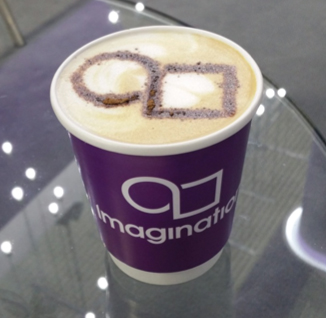
At this year’s MWC, Imagination Technologies launched the PowerVR Series8XE GPUs for cost-sensitive markets including low-cost phones, tablets, industrial displays, STBs, low- and mid-range automotive infotainment, and more. The company has been focused on broadening its support for graphics processing applications over the past 12 months and optimizing for area or physical footprint as much as performance to align more closely with the power/heat envelopes and requirements of mobile consumer devices. The result has been the retention of key accounts like Renesas as well as other big wins like MediaTek, with many others still to be announced. The gaming market in particular has taken a keen interest in Imagination’s ray tracing technology to alleviate one of the biggest current pains for developers: generating accurate and dynamic shadows and reflections. While some of Imagination’s other IP continues to feel competitive pressures in the embedded market, the company maintains a strong foothold in graphics where its roots lie.
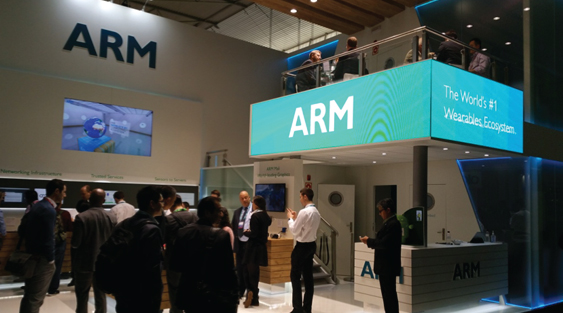
ARM made a couple splashes at MWC with its new ARM Cortex-A32 processor core and newly announced collaboration with HPE to accelerate IoT solutions development and deployments. The new 32-bit Cortex-A32 is built on the ARMv8-A architecture and is 25% more efficient than the current leading 32-bit core – the Cortex-A7 – which launched back in 2011. My conversation with ARM was much more tuned towards the high-end systems market opportunity for its Cortex-A50 series IP which has garnered heavy interest from traditional MIPS64 and PowerPC supporters. The opportunity for ARM’s big.LITTLE processing technology will be much greater in servers where savings and efficiency will be multiplied by the many-core system implementations that are now commonplace in the industry. For ARM, infiltrating the communications space will largely depend on the company’s ability to plug in its software ecosystem partners and enabling optimization through NFV functionality. ARM and a wide variety of T1 OEMs are behind the Open Platform for Network Functions Virtualization (OPNFV) initiative and less than a year ago the company demonstrated the first ARM-based reference platform for OPNFV alongside Enea. ARM has generated considerable momentum for its burgeoning 64-bit processor IP with much of the first product launches from partners slated for 2016.
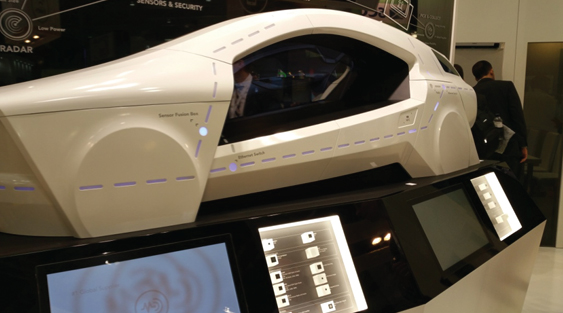
When NXP announced its intent to acquire Freescale last year, it was clear that the businesses were largely complimentary to each other – not the least of which was automotive products. At the show, NXP had a full automotive display (one side shown above) for its embedded processing solutions and components for ADAS, infotainment, Ethernet connectivity, vehicle gateways, and other applications. NXP’s leadership in automotive ICs has propelled the company to the front line of pushing next-generation V2X standards such as 802.11P for wireless access in vehicular environments on reserved 5.9 GHz spectrum. The other side of NXP’s automotive display included several demonstrations of how such vehicular networks would enable greater safety, vehicle platooning, faster emergency vehicle response, and improved overall roadway efficiency. NXP believes the technology has a real advantage over cellular-based solutions being pushed by carriers. It is hard to argue with them given the potential safety and security applications it can bring without dramatic latency or the need for more added services.
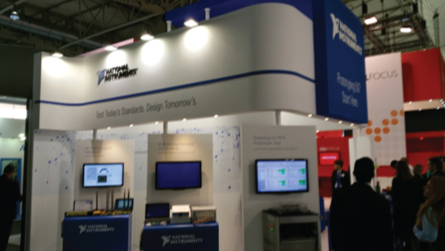
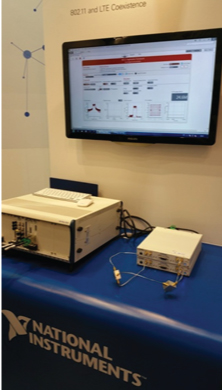
National Instruments always has some interesting new products and this year’s MWC did not disappoint with the launch of a new LTE-U/LAA testbed (pictured above to the right) to help close the current gap on 5G technology. The testbed includes an FPGA-based LTE physical layer in source code to test a variety of LTE-U and LAA scenarios and assess performance in real-time. What was interesting about the demonstration was the dramatic impact that shared spectrum has on data rates for systems built on existing infrastructure. A bit more interesting is that the same type of demonstration was being shown in other booths, but those had much different results indicating less noise and disruption on performance. National Instruments is helping lead a number of testbeds for 5G technologies. During the show, the company also announced in conjunction with the IIC and a variety of other industry leaders to develop the world’s first Time Sensitive Networking testbed. The new announcement which targets industrial networks further displays National Instruments’ leadership in next-generation networking across a variety of industries.
It was recently announced that Barcelona will remain the mobile capital of the world hosting MWC through 2023 and that this year’s event hosted over 100,000 attendees. It is exciting to see the conference continue to see tremendous success with a growing number of ecosystem participants from a variety of domains. Be sure to check back for the conclusion of our trip to Mobile World Congress 2016.